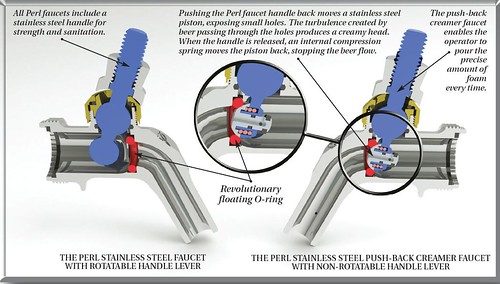View attachment 44696
But is this the same as a 575 or does it have a restrictor plate***? The above pours (fwrd pull) and creams (bkwrd pull??) and looks a little smaller than this (a European Stout Faucet)
I've been running a beer gas (co2/nitrogen mix) setup for a few months, and the tap that I have looks exactly like the one in this pic. There is a restrictor plate inside that has six holes, and which slows down the flow of beer considerably. I think this is more or less exactly what you'll get from the "european" style stout faucet that you also pictured there, though I know there is some variation in the amount of restriction on a faucet-by-faucet basis.
I also think that it will be really difficult to achieve the truly creamy/voluptuous texture you're after with CO2 alone, even with the Perlick creamer.
The Guinness tap handle marketing claims that it's doing something special on the "push" stroke that creates head. This is not true. The faucet is a simple cam mechanism that lifts a plunger and lets beer flow through the restrictor and faucet regardless of which way it's tipped. Tipping the handle, say, 10 degrees forward is the same as tipping it 10 degrees back. The range of motion is limited in the "push" direction, so I guess it's more foolproof that way, but it's not doing anything special internally.
I don't own a Perlick creamer, but from the design it looks like it really is doing something different on the "push" vs. the standard pull -- that is, it's letting beer into the glass through the equivalent of the Guinness/stout style restrictor (though it's a single narrow channel instead of six holes). But this *only* happens on the "push" stroke.
To pull a correct/creamy Guinness, the entire pint passes through the restrictor. It's high pressure, and if you let it sit for a few, the texture is the same regardless of how much or how little you pour, or how far open you hold the valve.
In the Perlick/CO2-only design, you basically have under-pressurized (and under-carbonated?) beer, and you let it flow normally through the faucet, then you top it off with artificially foamy beer by quickly reducing the pressure by forcing it through a small orifice just before serving. My guess is that this will yield a close approximation aesthetically, but that the foam will dissipate quickly, and the rest of the beer won't have the same creamy texture throughout.
Seems like a good opportunity for an experiment next time I have two Guinness kegs and a Perlick creamer faucet on hand

In the meantime, let us know how you make out.




















































![Craft A Brew - Safale BE-256 Yeast - Fermentis - Belgian Ale Dry Yeast - For Belgian & Strong Ales - Ingredients for Home Brewing - Beer Making Supplies - [3 Pack]](https://m.media-amazon.com/images/I/51bcKEwQmWL._SL500_.jpg)









